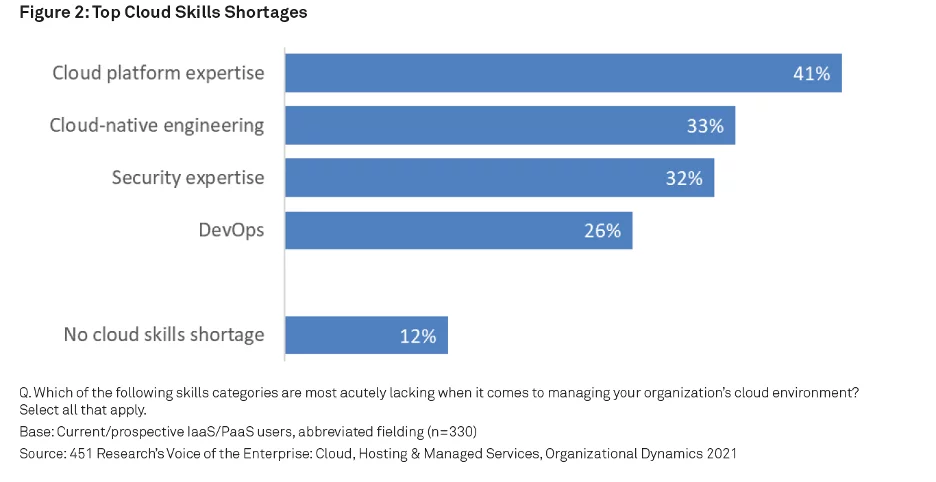Cloud native - a strategic priority
Every day, often multiple times a day, people engage with cloud services. We book restaurants online and find directions to them using cloud-based mapping services. We shop for groceries, clothes and other personal items using software-as-a-service (SaaS) applications. We entertain ourselves with sports and movies streamed directly to our personal devices.
Because cloud is infused in our lives already, it may be hard to imagine greater advancement on the horizon. Yet cloud nativity, fueled by the ingenuity and enthusiasm of the Cloud Native Community Foundation (CNCF) and the open source community, is really just taking off, according to a recent 451 Research S&P Global Market Intelligence report titled “Golden opportunity ahead with shift to cloud infrastructure, cloud native apps as default IT.”
As every business becomes a digital service provider, cloud is transitioning from a separate idea to simply how digital experience is delivered. Cloud native is a strategic priority for the majority of enterprises undertaking new development and application modernization. But it will take some years, opening the door of opportunity to those that can help deliver cloud native’s better, faster, and cheaper benefits, write the report’s authors, William Fellows, Jean Atelsek, and Jay Lyman.
Cloud native adoption
As a prevailing mindset and methodology for application and infrastructure architecture today, cloud native technology adoption is strong (see Figure 1).
It’s important to note that cloud native is not just one technology that runs on public cloud, but rather a set of capabilities that allow organizations to boost resiliency, security, connectivity and more because the addressable layer of infrastructure has moved up into the application. While most components are open source software at their core, the commercial ecosystem around them is exploding.
At last count in the 451 Research Cloud Price Index, organizations can purchase more than three million products from the major hyperscalers—Amazon Web Services, Microsoft Azure, Google Cloud Platform, and others—alone.
A new approach to engineering
The challenge with traditional, monolithic applications is that they’re inflexible and brittle as well as difficult to update and manage. The appeal of cloud native engineering is the ability to abstract functional parts of applications as microservices and maintain them independently. Because of the API-first culture of cloud native, infrastructure is mostly hidden, allowing developers and consumers to focus away from system maintenance to solving business needs and achieving outcomes using novel approaches—some of which include AI/ML.
Cloud native engineering benefits from abstraction, according to the 451 Research authors, which is enabled by:
- Observability – Three phases of observability approach (knowing, triaging, and understanding) mean engineers can quickly remediate problems and achieve better outcomes
- Containers – The packaging and deploying of microservices in apps in the cloud
- Kubernetes – Container orchestration for hybrid and multi-cloud infrastructure
- Serverless – Zero management of servers
- Service mesh – The ability to add networking independently
Shifting left to cut complexity
Cloud native developers introduced the world to the shift left concept. In practice, it simply means moving tasks typically done later to sooner in a process, i.e. adding security to application code in the design rather than the deployment phase. In cloud native developments, the authors note, code in composable applications can be instrumented with security and with connectivity via service mesh.
“As the applications become more complex, this opens up the possibility for automation based on the telemetry data that is coming from the processing of those jobs,” according to the 451 Researchers. “It is with increased levels of automation that some of the complexity that gets generated with greater quantities or greater dispersal of services will be tamed.”
While “applications, abstraction and automation characterize the move out of corporate datacenters and into public clouds, taking advantage of the scalability and resilience of those environments,” write the authors, none of it happens without effective, concurrent, organizational change.
Providers close skills gap but challenges remain
Change is never easy. Yet organizations carving out functional pieces as part of back-end application modernization can empower their organizations to see the possibilities and outcomes that come from doing incremental and continuous work, the authors believe.
With cloud providers offering more turnkey platforms, there is less complexity with lower learning curves today but what about tomorrow? “The bad news is organizations may not have quite so many levers or knobs to turn; the good news is they may not have quite so many levers or knobs,” according to the authors.
Cloud providers recognize skills shortages concern executives (see Figure 2) so they are helping to alleviate IT burdens by packaging granular views of reliability and security, performance and cost optimization, as well as responding in an automated way. This is becoming a sure way to refocus developers, DevOps, and SRE teams away from manual tasks and onto the new features, products, and innovation that can provide their organizations with competitive advantage.
Still, this year’s industry focus will be to continue to reduce cloud native complexity, the authors state, starting with additional abstractions and improved integration of parts to drive greater developer productivity. A key enabler: “increased use of systems’ own data and intelligence to automate tedious and fiddly manual processes” is expected. That way, teams can optimize the use of critical, in-short-supply talent.
How observability can help
For organizations embracing cloud native as well as those considering the fast-becoming-defacto approach, a comprehensive observability platform provides the ultimate flexibility to adapt to changing market conditions.
Download and read the full report.






